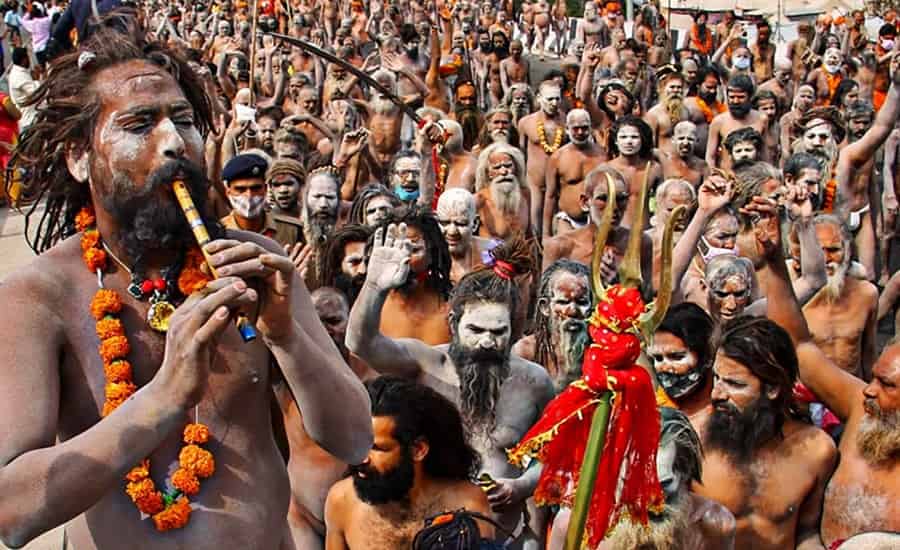
In this article, you’ll read everything about Kumbh Mela. It is biggest religious gatherings in the whole world. It is the most sacred festival of Hindus, held in India. Millions of people from all over the world and from all walks of life come together to participate in the Kumbh Mela. The festival is deeply rooted in Indian culture and mythology. Kumbh Mela shows the rich spiritual heritage of India.
This event is celebrated at four different locations in India : Prayagraj (Allahabad), Haridwar, Ujjain, and Nasik. Each site holds the Kumbh Mela in rotation. It does not have any one place. The time and place of Kumbh Mela depends on the specific astrological configuration of the Sun, Moon and Jupiter. You might know that it is believed that by taking bath in Kumbh Mela, people wash away their sins and attain salvation.
Aslo Read : HMPV: Understanding Human Metapneumovirus and its effects
The Origins of Kumbh Mela
The history of Kumbh Mela is thousands of years old. The origins of Kumbh are linked to the Hindu mythology of the Samudra Manthan, or the churning of the ocean of milk. According to this legend, the gods and demons together churned the ocean to obtain nectar. During the churning, a fight broke for the nectar. In the battle of Deva and Danava, a few drops of the nectar fell on four places : Prayagraj, Haridwar, Ujjain, and Nasik. Due to this reason, these places become sacred. The Kumbh Mela is held at these sites to honor this event.
The word “Kumbh” means pot in Sanskrit, symbolizing the pot that contained the nectar. “Mela” means fair or gathering. Together, Kumbh Mela means the gathering around the sacred pot of nectar.
Types of Kumbh Melas
There are four types of Kumbh Melas, each has its own significance as given below :
- Purna Kumbh Mela
- It is Held every 12 years.
- This Kumbh Mela rotates among Prayagraj, Haridwar, Ujjain, and Nasik.
- It is the largest and most significant Kumbh Mela.
- Ardh Kumbh Mela
- This is held every six years.
- This is celebrated only in Prayagraj and Haridwar.
- Maha Kumbh Mela
- It is held once in 144 years, only in Prayagraj.
- This event is extremely rare and considered the holiest of all.
- Kumbh Mela at Other Sites
- Smaller versions of the festival occur at other times.
- These include Magh Mela in Prayagraj and other regional events.
Locations of the Kumbh Mela
1. Prayagraj (Allahabad)
- Prayagraj is located at the junction of the Ganga, Yamuna, and the Saraswati rivers (No physical existence but traces of it have been found).
- This place is called the Sangam and is considered the holiest among the four.
- The Maha Kumbh Mela is held in Prayagraj once every 144 years.
2. Haridwar
- This holly city is situated on the banks of the holy river Ganga.
- It is one of the seven holiest places in Hindu religion.
- It is believed that Bathing here during Kumbh Mela is to bring a lot of spiritual benefits.
3. Ujjain
- It is situated on the banks of the Shipra River in Madhya Pradesh.
- The festival here is deeply connected with Lord Shiva.
- Ujjain is also known for the Hindu temple Mahakaleshwar, which is one of the 12 Jyotirlingas.
4. Nasik
- It is in Maharashtra. It is situated on the banks of the Godavari River.
- According to Hindu faith and mythology, a part of the nectar fell here.
- Nasik is also associated with the epic Ramayana.
Rituals and Activities
1. Sacred Bathing (Snan)
- Snan in kumbh i.e. bathing in the holy rivers is the most important ritual.
- It is believed that it washes away sins and purifies your soul.
- There are certain days called Shahi Snan, which are considered the most auspicious for bathing.
2. Prayers and Offerings
- Pilgrims offer flowers, incense and prayers along the riverbank.
- Many people honor their ancestors according to the rules of Hindu scriptures.
3. Religious Discourses
- Saints, gurus and scholars conduct spiritual discussions.
- These discourses attract a large number of people seeking enlightenment.
4. Sadhus and Akharas
- The festival is famous for the participation of sadhus (holy men).
- Many of them belong to akharas, which are monastic orders.
- Naga sadhus, known for their austerity and ash-covered bodies, are a major attraction.
5. Cultural Events
- The Kumbh Mela also features music, dance, and theatrical performances.
- These events reflect India’s cultural diversity.
Astrological Significance
The dates of the Kumbh Mela are determined by astrology. The festival is held when the following alignments occur:
- In Prayagraj, the festival is organised when Jupiter is in Aries and the sun and moon are in Capricorn.
- In Haridwar, it takes place when Jupiter is in Aquarius and the sun enters Aries.
- In Ujjain, the festival occurs when Jupiter is in Leo and the sun is in Aries.
- In Nasik, the event is held when Jupiter and the sun are in Leo.
These alignments are considered highly auspicious.
Pilgrims and Visitors
Because it is the most popular and large gathering of spiritual people, therefore it attracts people from all over the world. Devotees, tourists and researchers come to witness this grand event.
- Pilgrims : Many pilgrims come here to fulfill their religious beliefs and to receive the blessings of God.
- Sadhus and Saints : Many saints and sages from different sects gather at Kumbh to perform their religious rituals and preach their teachings.
- Tourists : International tourists from all over the world come to see, understand and experience Indian culture and spirituality.
- Photographers and Journalists : As the event offers a unique opportunity to understand the essence of India, it is visited by many photographers and journalists from across the world.
Scale of the Event
The Kumbh Mela takes place on a very large scale. Millions of people gather in one place. Temporary cities are built to accommodate the pilgrims. These cities include :
- Shelter for incoming visitors.
- Medical facility to deal with any medical emergency.
- Sanitation system to maintain cleanliness in the fair area.
- Free food stall for the visiting tourists (Bhandara or langar).
- Stringent security measures for the safety of visitors.
The Indian government and local authorities work together to manage the crowd and logistics.
Environmental and Cultural Impact
Both positive and negative impacts of Kumbh Mela are seen :
Positive Impacts
- Cultural Exchange : Organizing Kumbh Mela promotes unity and society among the people of the country and abroad and reflects your unity.
- Economic Growth : Since millions of tourists come to the Kumbh Mela, therefore, local business and tourism increase during the festival.
- Preservation of Traditions : Kumbh Mela plays an important role in keeping alive the Sanskrit and ancient customs and rituals of India. 1Es
Challenges
- Pollution : Large gatherings cause pollution in rivers and nearby areas.
- Waste Management : Managing the waste generated by millions of people is a huge task.
- Overcrowding : Crores of people come to this fair, hence the arrival of huge number of people can put pressure on resources and infrastructure.
To deal with all such problems, efforts are being made by the government on a war footing. Environmentally friendly measures and strict regulations are being implemented to reduce the negative impact on the environment.
UNESCO Recognition
UNESCO included the Kumbh Mela in the list of historical heritage of humanity in 2017. This recognition given by UNESCO adds this festival with world importance. It also emphasizes the need to preserve its traditions to establish it in the future.
Conclusion
Kumbh Mela is not just a religious event. It is a celebration of faith, spirituality and humanity. The festival unites millions of people, regardless of their social or economic background. It is a testament to the enduring power of faith and the richness of Indian culture. Through its rituals, mythology and grandeur, Kumbh Mela continues to inspire awe and reverence. It reminds us of the importance of spirituality and the pursuit of inner peace.
Also Read
- Hydrogen Spectrum : Lines, Series and Everything
- Photo Electric Effect : Definition, Types and Everything
- Essay on The Advantages and Disadvantages of Social Media
- Understanding Secularism : Meaning, Importance and Impact on Society
- Einstein’s Theory of Relativity Explained : Space, Time, and Gravity
To Wikipedia : Click Here


